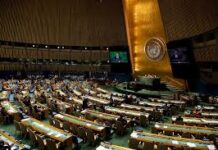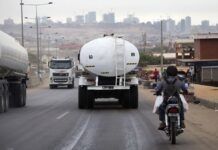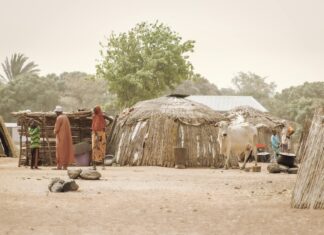(Reuters) – Protesters denouncing Iran’s clerical rulers took to the streets and riot police deployed to face them on Monday, in a third day of demonstrations after authorities
acknowledged shooting down a passenger plane by accident.
Demonstrations at home — some apparently met by a violent crackdown — have become the latest consequence of one of the most destabilizing escalations between the United States and Iran since the Iranian revolution of 1979.
Video from inside Iran showed students on Monday chanting slogans including “Clerics get lost!” outside universities in the city of Isfahan and in Tehran, where riot police were
filmed taking up positions on the streets of the capital.
Images emerged from the previous two days of protests showing wounded people being carried and pools of blood on the ground, while the sound of gunfire could be heard.
Authorities denied that police had opened fire. U.S. President Donald Trump, who raised the stakes last week by ordering the killing of Iran’s most powerful military commander,
tweeted to Iran’s leaders: “don’t kill your protesters.”
Tehran has acknowledged shooting down the Ukrainian jetliner by mistake on Wednesday, killing 176 people, hours after it had fired at U.S. targets in Iraq to retaliate for the killing of General Qassem Soleimani in a drone strike in Baghdad.
Iranian public anger, rumbling for days as Iran repeatedly denied it was to blame for the plane crash, erupted into protests on Saturday when the military admitted its role.
Scores, possibly hundreds, of protesters were videoed at several sites in Tehran and Isfahan, a major city south of the capital.
“They killed our elites and replaced them with clerics,” demonstrators chanted at a protest outside a university in Tehran on Monday, referring to Iranian students returning to
studies in Canada who were among those killed on the flight.
‘DON’T BEAT THEM’
Videos posted late on Sunday recorded gunshots in the vicinity of protests in Tehran’s Azadi Square. Wounded were being carried and security personnel could be seen running
with rifles. Other posts showed riot police hitting protesters with batons as people nearby shouted “Don’t beat them!”
“Death to the dictator,” footage circulating on social media showed protesters shouting, directing their fury directly at +Ayatollah Ali Khamenei, Iran’s supreme leader since 1989.
Reuters could not independently authenticate the footage.
State-affiliated media reported the protests on Saturday and
Sunday in Tehran and other cities, without giving such
details.
“At protests, police absolutely did not shoot because the
capital’s police officers have been given orders to show
restraint,” Hossein Rahimi, head of the Tehran police, said in
a statement carried by the state broadcaster’s website.
Tehran’s showdown with Washington has come at a
precarious time for the authorities in Iran and the proxy
forces they support to wield influence across the Middle
East. Sanctions imposed by Trump have caused deep harm to
the Iranian economy.
Iranian authorities killed hundreds of protesters in November
in what appears to have been the bloodiest crackdown on
anti-government unrest since the 1979 revolution. In Iraq and
Lebanon, governments that have the support of Iran-backed
armed groups have also faced months of hostile mass
demonstrations.
Trump wrote on Twitter late on Sunday that National
Security Adviser Robert O’Brien had “suggested today that
sanctions & protests have Iran ‘choked off’, will force them
to negotiate.”
“Actually, I couldn’t care less if they negotiate. Will be
totally up to them but, no nuclear weapons and ‘don’t kill
your protesters’,” he wrote, repeating his earlier tweets
making similar calls to the Iranian authorities not to open
fire.
ESCALATION
Iran’s government spokesman dismissed Trump’s comments,
saying Iranians were suffering because of his actions and
they would remember that he had ordered the killing of
Soleimani, whose death on Jan. 3 prompted days of
mourning ceremonies.
Trump precipitated escalation with Iran since 2018 by
pulling out of a deal between Tehran and world powers under
which sanctions were eased in return for Iran curbing its
nuclear program. Trump has said his goal is to force Iran to
agree to a more stringent pact.
Iran has repeatedly said it will not negotiate as long as U.S.
sanctions are in place. It denies seeking nuclear arms.
The recent flare-up began in December when rockets fired at
U.S. bases in Iraq killed a U.S. contractor. Washington
blamed pro-Iran militia and launched air strikes that killed at
least 25 fighters. After the militia surrounded the U.S.
embassy in Baghdad for two days, Trump ordered the strike
on Soleimani, known as the architect of Iran’s network of
regional proxies.
Iran retaliated on Wednesday by firing missiles at Iraqi bases
where U.S. troops were stationed, but did not kill any
Americans. The Ukrainian plane, on its way to Kiev, crashed
hours later. Most of those killed were Iranians or Iranian dual
nationals. Scores were Canadians, most believed to be dual
nationals who had traveled to Iran to visit relatives there.
After days of denying responsibility, commanders of Iran’s
Revolutionary Guards issued profuse apologies. Iran’s
president called it a “disastrous mistake”. A top commander
said he had told the authorities on the day of the crash it had
been shot down, raising questions about why Iran had
initially denied it










